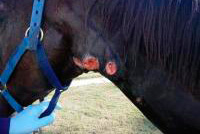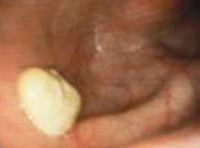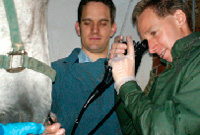Equine Strangles
Identification of carriers of Streptococcus Equi

Dr. Andrew Waller (Animal Health Trust, Reino Unido), British Horse Society Scotland, STEPS (Strategy To Eradicate and Prevent Strangles)
Streptococcus equi (S. equi) is the bacterium that causes equine strangles. Some horses are carriers of S. equi, meaning that they are infected with S. equi but do not show any signs of the disease. These horses can be a source of S. equi for other (susceptible) horses. Young horses (weaning foals, yearlings and two-year-old horses) are particularly susceptible to this disease; however, strangles can affect horses of any age.
Strangles outbreaks occur due to the movement of horses or the introduction of carriers in a population of susceptible horses. Therefore, the identification and treatment of strangles carriers eliminates the possibility of having potentially infectious horses and can significantly reduce the probability of having an outbreak in a yard or stud farm.
S. equi carriers normally harbour the bacterium in the gutural pouches, which can be inflammed. However, in some cases the inflammation may not be visible and S. equi can form a thin and invisible layer of bacteria (biofilm).
Which horses and when to test?

Dr. Andrew Waller (Animal Health Trust, Reino Unido)
- Horses showing acute signs typical of strangles: Diagnosis can be confirmed by culture and/or quantitative PCR (real time PCR) of S. equi in a sample of nasal exudate, lymph node abscess content or nasopharyngeal swab.
- At the end of an outbreak of strangles (at least 30 days after the last clinical signs were seen in all the affected horses), the horses which showed signs of equine strangles should be investigated. The reference or “gold standard” method to identify possible carriers of S. equi is the culture and quantitative PCR of a sample of guttural pouches wash, together with a nasopharyngeal swab. An alternative is to analyse three nasopharyngeal swabs taken in three consecutive weeks (one swab per week) by culture and quantitative PCR.
- Horses that do not show clinical signs of strangles and which have to be analysed prior to their introduction into a yard or stud farm, or after an outbreak of strangles if they were not affected: These horses can be analysed serologically by ELISA, testing two samples taken with a lapse of 14 days in order to demonstrate that there is no seroconversion. If the first sample was positive or if there was seroconversion, the possibility of that horse being a carrier of S. equi should be investigated (by means of culture and quantitative PCR).
Sampling for Strangles diagnosis
Nasopharyngeal swab
Collection of samples in horses using a nasopharyngeal swab

Dr. Jamie Gartside (Tay Valley Vets, Reino Unido), British Horse Society Scotland, STEPS (Strategy To Eradicate and Prevent Strangles)
Guttural pouches washes
In those horses with a positive result in a nasopharyngeal swab, or in those cases where the carrier status needs to be ruled out, the endoscopic examination and wash of the guttural pouches is essential.
Method of collection for guitural pouch washes:
- Pass the endoscope through the central nasal meatus of the same side of the head as the guttural pouch to be sampled to the level of the common pharynx. The openings of the guttural pouches are visible as mucosal flaps on both sides of the pharynx.
- Pass the biopsy forceps or a similar guide instrument through the biopsy chanel and under the flap of the guttural pouch and extend the endoscope into the pouch. Slightly twisting the endoscope helps to introduction into the pouch.
- Once into the pouch, make a thorough inspection of all parts and later replace the guide instrument in the biopsy chanel with a sterile catheter.
- Ensure the head of the horse is elevated before the instillation and aspiration of approximately 50 ml of sterile saline into the pouch from a syringe attached to the catheter.
- The entire wash should be placed in a leak-proof universal container which should be labelled with the name of the horse and the origin of the aspirate (right or left guttural pouch).
The wash should be sent to the laboratory as soon as possible (it should arrive to the laboratory in less than 48 hours) and should be accompanied by the corresponding submission form.
Serology - S. equi ELISA
This test identifies horses that have been exposed to S. equi in the past 6 months and therefore have developed antibodies against protein M of S. equi (SeM).
- If the first sample is negative in the ELISA, a second sample should be taken with a time lapse of at least 14 days from the first sample; if the second sample is negative, the horse would be ruled out as a S. equi carrier.
- If the first sample is negative in the ELISA and the second sample is positive, the horse has come into contact with S. equi and therefore it should be investigated by culture and quantitative PCR.
- If the first sample is positive in the ELISA, the horse should be investigated by culture and quantitative PCR.
For further information and the consultation of questions regarding the diagnosis, treatment or control of an outbreak of strangles:
Equine Health Surveillance Unit
VISAVET Health Surveillance Centre
Complutense University Madrid (Spain)
Tel.: (+34) 913943999
seviseq@ucm.es
Bibliography
- Waller, A.S. 2013. Strangles: Taking steps towards eradication. Vet Microbiol. 167(1-2): 50-60.
- Newton, J.R., Wood J.L., Dunn K.A., DeBrauwere M.N., Chanter N. 1997. Naturally occurring persistent and asymptomatic infection of the guttural pouches of horses with Streptococcus equi. Vet. Rec. 140: 84–90.
- Robinson, C., Steward K.F., Potts N., Barker C., Hammond T.A., Pierce K., Gunnarsson E., Svansson V., Slater J., Newton J.R., Waller A.S. 2013. Combining two serological assays optimises sensitivity and specificity for the identification of Streptococcus equi subsp. equi exposure. Vet. J. 197(2):188-191.
- Sweeney, C.R., Timoney J.F., Newton J.R., Hines M.T. 2005. Streptococcus equi infections in horses: guidelines for treatment, control, and prevention of strangles. J. Vet. Intern. Med. 19:123–134.
- Verheyen, K., Newton J.R., Talbot N.C., de Brauwere M.N., Chanter N. 2000. Elimination of guttural pouch infection and inflammation in asymptomatic carriers of Streptococcus equi. Equine Vet. J. 32: 527–532.
- Waller, A.S., Jolley K.A. 2007. Getting a grip on strangles: recent progress towards improved diagnostics and vaccines. Vet. J. 173: 492–501.
- Webb, K., Barker C., Harrison T., Heather Z., Steward K.F., Robinson C., Newton J.R., Waller A.S. 2013. Detection of Streptococcus equi subspecies equi using a triplex qPCR assay. Vet. J. 195: 300–304.


